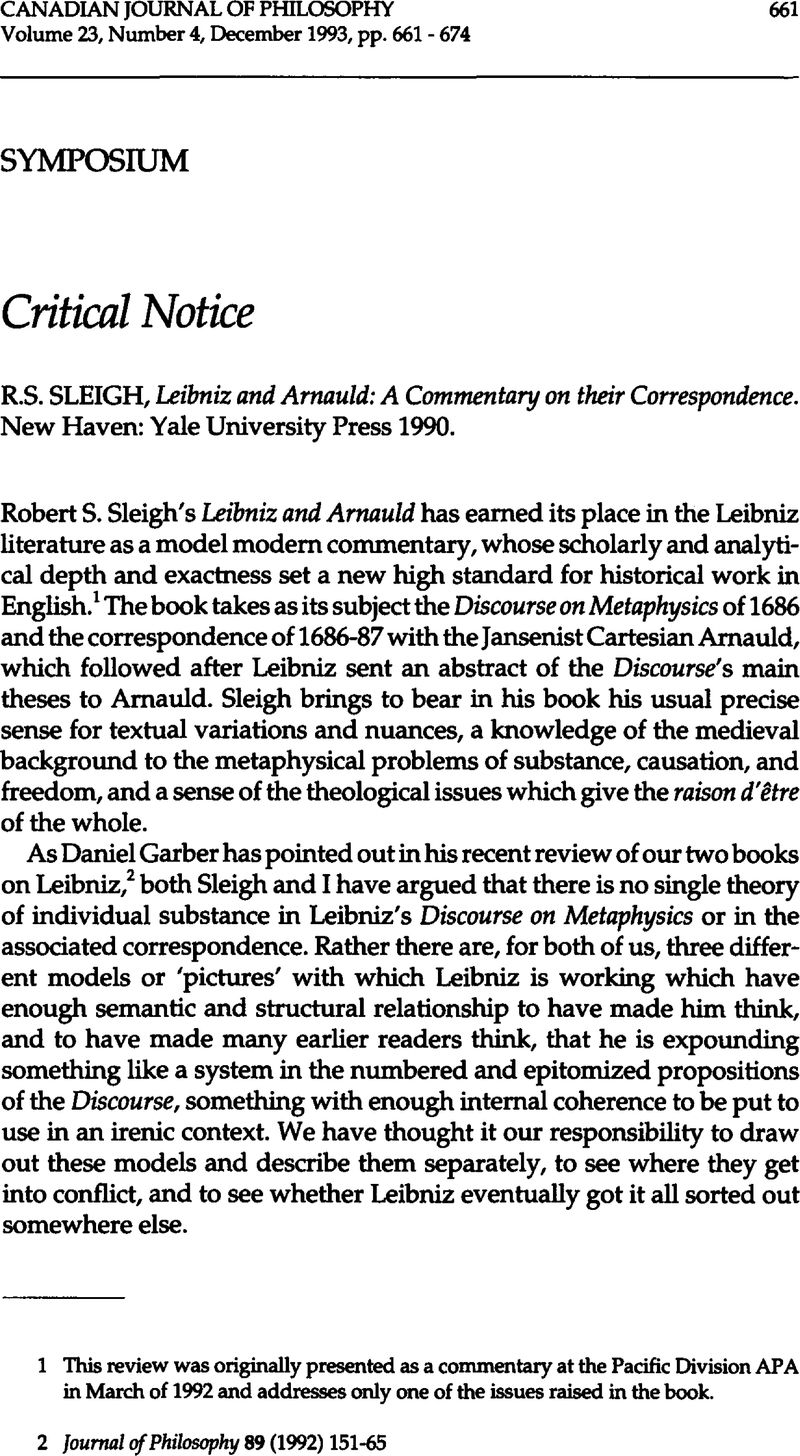Published online by Cambridge University Press: 01 January 2020

1 This review was originally presented as a commentary at the Pacific Division AP A in March of 1992 and addresses only one of the issues raised in the book.
2 Journal of Philosophy 89 (1992) 151-65
3 DM refers to the Discourse; LA refers to Gerhardt’s edition of the Leibniz-Arnauld Correspondence in volume 2 of Die philosophische Schriften von G. W. Leitmiz, 7 vols. (Hildesheim: Olms 1965). (Hereafter G.)
4 Arguably, the Hobbes of De Corpore (actually well known to Leibniz) was not actually a materialist; in the imagination of readers of Leviathan, however, he was.
5 Sleigh himself mentions that Thomas’s theory of soul-body union was specifically directed against the Averroists, Leibniz, and Arnauld (99).
6 This means, of course, that a dead body cannot be understood as a material thing abandoned by its soul, as Descartes would have it (’Passions of the Soul,’ Pt. I, Prop. 5, in The Philosophical Writings of Descartes, 2 vols., J. Cottingham, R. Stoothoff, and D. Murdoch, eds. [Cambridge: Cambridge University Press 1985], vol 1, 329). Leibniz’s ‘kernel theory’ was that a soul does not abandon its body after death, but remains attached to a small organized part of it.
7 ‘Aus und zu Cordemoy,’ Vorausedition zur Reihe VI, Saemtliche Schriften und Briefe (Muenster: Leibniz-Forschungsstelle [private printing]1985), vol. 4, 696
8 There is no direct evidence that Leibniz actually read this popular book or a review of it; if not, there were other opportunities for him to be informed or reminded of pananimistic doctrines.
9 de Fontenelle, Bernard Dialogues, Gephardt, Nina ed., Hargreaves, H.A. trans. (Berkeley: University of California Press 1990), 45Google Scholar
10 Letter to Arnauld, 30 April, 1687, G 2, 99; Montgomery, G. trans., Discourse on Metaphysics (La Salle, IL: Open Court 1973), 194-6Google Scholar
11 Wilson, C. ‘Leibniz and the Animalcula,’ in Stewart, M.A. ed., Oxford Studies in the History of Philosophy (London: Oxford University Press forthcoming)Google Scholar
12 ‘Leibniz and the Foundations of Physics: The Middle Years,’ in Okruhlik, K. and Brown, J.R. The Natural Philosophy of Leibniz (Dordrecht: Reidel 1985) 27-130CrossRefGoogle Scholar
13 See especially the Letter to Des Bosses, June 16, 1712, G 2, 450-2; cf. Wilson, C. Leibniz’s Metaphysics (Princeton: Princeton University Press 1989), 180-99.Google Scholar
14 On Sleigh’s view, it is for theological reasons that Leibniz requires persisting individuals rather than transitory sequential states. This requirement seems to me however to be prior to any desire to conform to dogma, and to reflect Leibniz’s usual dislike of the idea of being absorbed into the Whole or broken up into innumerable Parts.
15 Letter to Fardella, March 1690, in Foucher de Careil, A. ed., Nouvelles lettres et opuscules inédites de Leibniz (Paris, 1857), 324Google Scholar
16 Efforts to show that these two pictures can be superimposed, that monads can be the ground of other monads’ phenomena, despite the world-apart status of each, seem to me unconvincing: if perception is extensional, even if non-causal, ‘worldapartness’ does not hold.